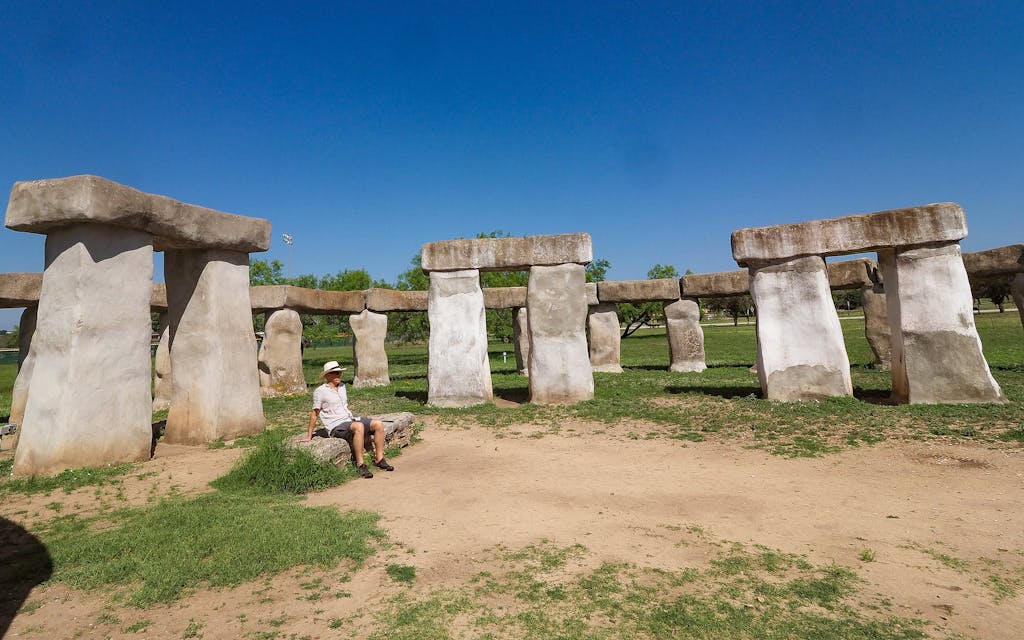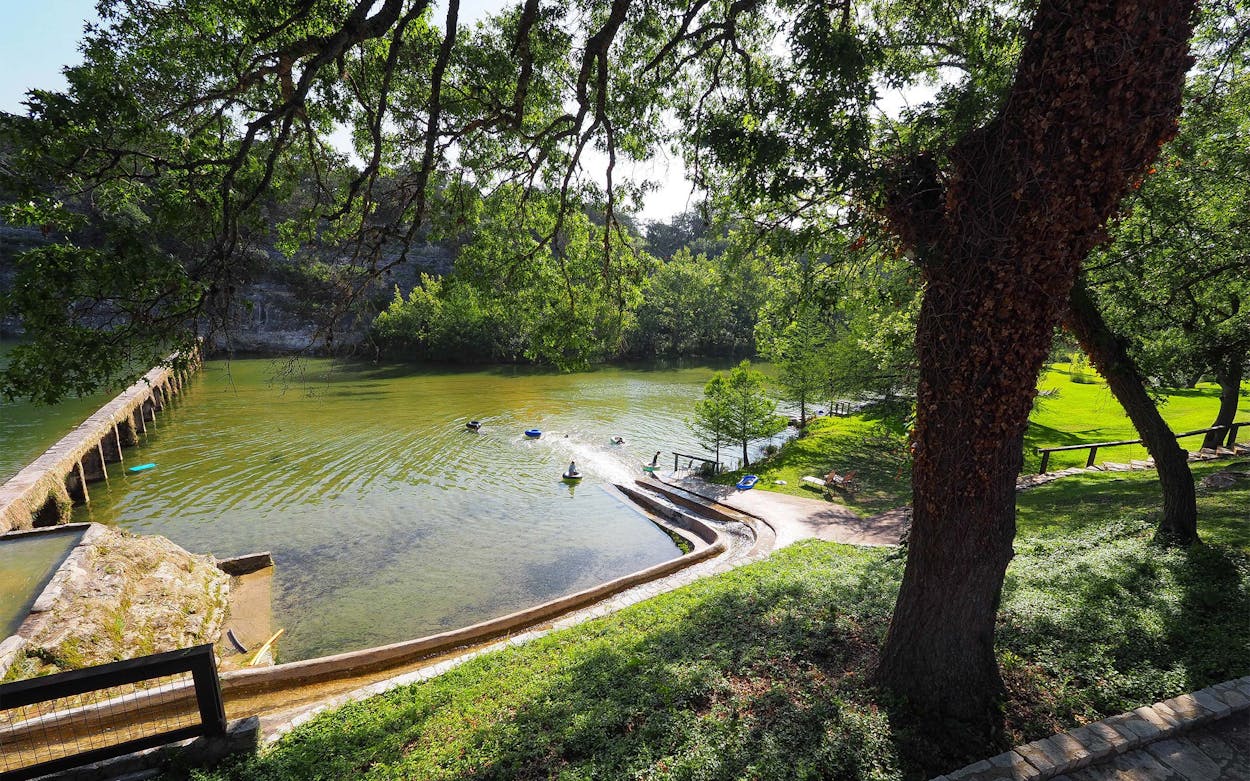Twelve miles west of Kerrville, the north and south forks of the Guadalupe River merge in a tangle of cool blue-green water and towering cypress trees around the small community of Hunt. Stone cottages, overnight camps, and cozy lodges dot the banks, and in the summer, tourists on inner tubes bob in the water like dumplings in broth. For many Texans, this quiet rural stretch of the Hill Country is bliss—a place where you can spend all day futzing on the river or sitting in a lawn chair alongside friends and a cooler full of cold ones.
With its snaking ribbon of water and rugged limestone cliffs, Hunt is a quintessential Texas Hill Country paradise. Settlers planted roots here starting in the 1850s, and by 1913, the Hunt Post Office, named for landowner R. F. Hunt, opened. Not long after that, travelers, drawn by the natural beauty of the surroundings, started coming to cool their heels in the river.
“This whole area in the Hill Country—it just runs slower,” says Brandi Sheffield, who has lived here since the 1970s and now runs the nearby Ole Ingram Grocery with her husband. “We just go at a different pace than everywhere else, and it’s more relaxing.”

Stay
I never went to overnight camp when I was a kid growing up in Central Texas, but if I did, I’d want to do it here. Every summer, campers at Heart O’ the Hills, Camp Mystic, Camp Waldemar, and Camp Stewart while away the sweaty summer days of adolescence with canoe races and archery competitions, secret handshakes, and goofy chants in the dining hall. On my way down Texas Highway 39, I passed half a dozen of those camps, gaggles of awkward preteens milling around on fields carpeted in tiny yellow flowers and climbing aboard fat ponies for riding lessons.
Just as scenic, albeit with fewer kids around, was the place where my husband and I had booked a room: River Inn Resort, which perches on the top of a hillside overlooking a dammed-up stretch of the river. As soon as I walked into the main lodge to pick up my key and saw the freezer full of ice cream bars and the view of the river, I knew I’d landed in the right place.
Nearly all the rooms in the resort are individually owned. The vibe here is retro and old-school—and not the fancy, made-for-Instagram kind. The folks who stay here have been coming for decades, and it looks like not much has changed.
According to the manager, the first level of the two-story structure originally served as temporary housing for workers at HemisFair ’68, the World’s Fair held in downtown San Antonio to highlight the culture and history of the city. After the fair ended and the buildings were no longer needed, they were trucked here and arranged around a central patio overlooking the water. A second story was added later, and today there are picnic tables and lounge chairs clustered around huge shade trees.
When I wandered down to the river to check out the concrete ditch that runs alongside the dam and serves as a flume ride, I met a group that had been coming to the old hotel for nearly four decades. Cousins Carroll Adcock, 70, of Temple, and Randy Boatright, 71, of San Antonio, pulled up a chair for me while thirty of their closest family members frolicked in the background. “It’s underdeveloped, and that’s why I like it,” Boatright said. The youngest member of this year’s entourage had been born barely a week earlier; Adcock told me he hasn’t missed a reunion in 37 years. “We eat too much, we drink too much, we stay up too late and we’re probably too loud,” a passing family member chimed in.
My husband and I made our way down to the river, where we hopped in and scrambled onto a rainbow-colored inflatable unicorn the size of a minivan that was tethered to the stone retaining wall. Then we plopped back into the river and swam out to a floating platform, where I never wanted to get out.
Eat + Shop
The Hunt Store, established in 1946, is a destination as popular with summer campers in search of a sugar fix as tourists like me looking for a blast of nostalgia. The heart of the community beats inside this aging wooden structure, where folks still gather in front of the fireplace to shoot the bull. The store’s website says locals sometimes wait outside on the porch for the store to open in the morning, then help set up chairs and make coffee to start the day.
I saluted the store’s mascot, a taxidermy beaver named Bucky (not to be confused with that other, more corporate beaver mascot you’re thinking of) that stared down from atop a shelf. A sunflower was tucked behind one of his dime-sized ears. Then I made my way to the little restaurant in back called the Hunt Rock Café. I munched a cheeseburger at a table made from a thick plank of cypress wood as a group of bikers placed their orders, then wandered out to the patio, where bands sometimes perform. The store sells gas, beer, basic groceries, fishing gear, and T-shirts.
Also worth a stop is the Hunter House Café in Ingram, on the outskirts of Kerrville. The place is always packed, so if you go, try to hit it at an off hour. It specializes in comfort food, and the generously sized special of the day during our visit—a platter of chicken and beef fajitas, with rice and beans on the side—easily fed two of us. The café is only open for breakfast and lunch.

See + Do
I could’ve soaked in the river forever, but eventually I emerged. Saturday is rodeo night in Hunt, and we didn’t want to miss the action. I tugged on my cowboy boots and hat, and we drove four miles down the road to Crider’s Rodeo and Dancehall. By the time we arrived, dust was rising from the parking lot as camp counselors, locals, and vacationers filed through the gates and settled into the bleachers.
At 8 p.m. sharp, a cowboy bearing an American flag galloped into the ring and the show began. The rodeo, first held as a fundraiser to benefit the Hunt School PTA in 1925 and now held every weekend from Memorial Day to Labor Day, includes everything from bull riding and calf roping to barrel racing and mutton busting. And while watching a full-grown man get launched skyward off the withers of a pissed-off 1,200-pound bull has its merits, I couldn’t take my eyes off the pint-sized cowgirl in pink boots doing her best to cling to the shoulders of a stampeding sheep.
When the dust settled two hours later, everyone scooted over to the adjacent open-air dance hall for live music. Billie Jo Jones was performing that night, and the dance floor was so packed that I could barely squeeze in under the big oaks for a song or two.
The next morning began with another swim in the river and a short paddling trip upstream to check out the rocky, pocked expanse of limestone riverbed that some of the other guests called “the sandbar.” But by noon we were on our way again, eager to see one of the top attractions in Kerr County: Stonehenge II.
The ring of faux boulders arose in 1989, when Hunt resident Al Shepperd enlisted the help of his neighbor, Doug Hill, to build a circle of rocks resembling the famous stone monument across the pond. We couldn’t resist tapping on the hollow-sounding slabs, vaguely reminiscent of Cadillac-sized Twinkies, and dancing through them a la Maria in The Sound of Music. The structure is 90 percent as tall and 60 percent as wide as the original, which rises from the windswept Salisbury Plain near Wiltshire, England. I doubt it’ll be as enduring.
Sheppard died in 1994, and in 2010, the whole wacky creation, along with a pair of thirteen-foot Easter Island heads, was moved to the grounds of the Hill Country Arts Foundation, a nonprofit that puts on plays, offers classes, and hosts art exhibitions. You can drop by during daylight hours for free.






